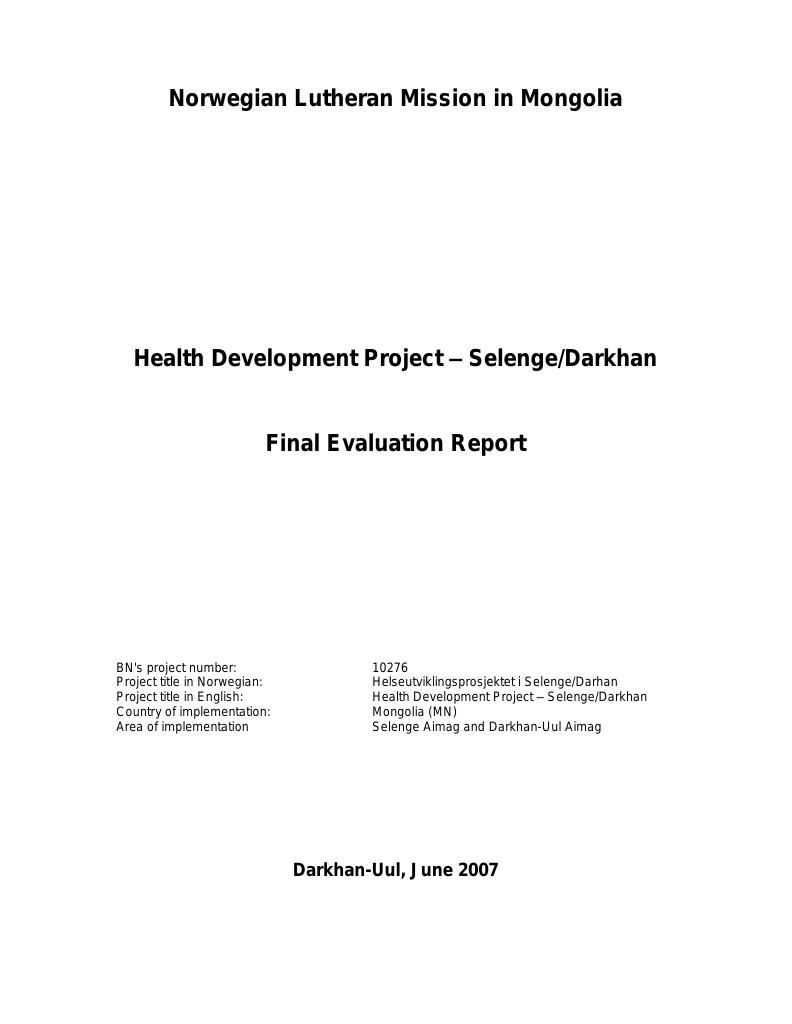Evaluering
Health Development Project – Selenge/Darkhan, Final Evaluation Report, June 2007
Background: The first project period from 1998-2000 was a pilot period. The second project period from 2001-2005 was seen as the main implementing period. The third and current project period from 2006-2008 is seen as the phase-out period, in which additional activities are implemented as a follow up of previous years. The main goal for this period is to promote the participation of the general population in establishing healthy behavior and prevent 0-8 year old children from common diseases and death. The main goal for phase-out is to support local organizations in running the developed and implemented activities on their own and build structures for sustainability. Purpose/objective:One of the focuses for the evaluation was the activities transferred to local partners at the end of the second project period to see whether these activities are still sustained. With this, the project wanted to know what lessons can be learned from the last phase-out. Another purpose was to evaluate the efficiency and operational concerns (implementation, technical, administrative, financial), as well as the project's effectiveness, outcome, and impact. Finally, the project's relevance to local needs and priorities and the project's sustainability was also evaluated. The evaluation team was also asked to provide recommendations for the remaining time of the project and consider what parts of the project that may be useful for other organizations. Methodology:The evaluation team reviewed reference documents and Information, Education & Communication (IEC) materials, interviewed key informants, arranged group discussions, invited caregivers to fill out questionnaires, visited and observed project sites, and had informal discussions with individuals. Key findings:Statistics show that the project succeeded in its goal to reduce the mortality and morbidity rates. The improved knowledge and skills of health workers, the improved equipment, and the use of proper information materials are seen as the main reasons for these decreases. As a general impression it seems that the project has succeeded in transferring the relevant activities from the term 2001-2005 to local partners. The activities of running Health Information and Training Centers, training of beneficiaries, development and reprinting of simple IEC material, running of training rooms, organizing post-graduate training for health care providers and staff and development of local TV/radio health programs are fully or partly taken over by local institutions. The activities in the plan for 2006 till 2008 are implemented and monitored according to plan. The focus on health education in kindergartens and schools has resulted in a national initiative for developing a new health education curriculum for the whole primary education system in Mongolia. The structure to work with trained teachers that are training other teachers means that the implementation of the transferred knowledge will go on in a sustainable way with a minimum use of resources. Also, the focus on caregivers and children shows a good result in their knowledge and changes of behavior and attitude to health issues. The materials used for communication with caregivers and children are good examples for other organizations that want to change the attitude and behavior of citizens regarding health prevention and health care. The unique approach focusing on all aspects of child health prevention and health care and to involve healthcare workers as well as caregivers in a whole aimag is also worth sharing with other organizations. The current success is influenced by this unique approach, which is effective and one of the bases for sustainability. The structure of working with trainers that are trained within the program to train others is very efficient. The strategy and the way the NLM-M worked with local authorities is a model for sustainability. Recommendations:• It is recommended that concrete plans should be made for how and when NLM-M will withdraw, and how the partners will take over.• There should be a very proactive approach to ensure that Integrated Management of Childhood Illness (IMCI) is budgeted into future local budgets.• NLM's financial involvement in the implementation of IMCI should be minimized, while the technical job of advising government on financial planning should be maximized.• The project management should make an effort to see how the materials can be produced in a cheaper and more sustainable by the local institutions.• Possibilities of spreading information material on CD/ROM or video should be considered.• The training material for families in Darkhan and Selenge should be corrected and improved for further use.• The project should focus more on reducing mortality rates of children under the age of 1.• There seems to be a weakness in the cooperation between health authorities and education authorities at the aimag level. The project is encouraged to outline the preferred content of the cooperation and continue to make efforts to implement and improve it.• A presentation on national ministerial level can be considered about items that can be useful for future development, like cooperation between health and education, development of campaigns, cooperation between ministries and NGOs.• NLM-M and the partners in Darkhan-Uul aimag and Selenge aimag are encouraged to present project experiences on a conference or seminar for aimag governments. Comments from the organization, if any: The project has been encouraged to follow up the recommendations given in the evaluation report.
